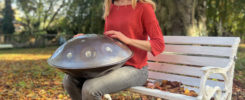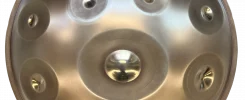What is corrosion?
The handpan is a musical instrument made from two half-shells glued together. Usually, those shells are produced from sheet steel. One of the problems that naturally come with using steel is corrosion. This is reducing the instrument’s lifespan especially if the instrument is improperly cared for. This short article will discuss the phenomenon of rust, a special type of corrosion.
So, what is corrosion?
Corrosion is the process by which metals are slowly broken down through chemical reactions with substances in their environment. One special case of corrosion is rust. This is a process, which is called a redox reaction. It is involving oxygen and water from the environment with the iron in the steel.
So what happens on the element level? We want to explain this a bit more chemically:
First, solid iron (Fe) dissolves in water producing iron ions (Fe2+) and electrons (e–). Those electrons react with oxygen (O2) and water (H2O) from the environment and form hydroxide ions (OH–). The iron ions, which can be denoted as iron(II), react further with Oxygen (O2) from the environment. In this process, they form another type of iron ions (Fe3+), denoted as iron(III), and oxygen ions (O2-). This results in a solution containing iron(II), iron(III), and water. Next, both iron(II) and iron(III) react with water (H2O) to form different forms of rust (Fe(OH)x) and hydrogen ions (H+). Finally, those hydrogen ions (H+) react with the hydroxide ions (OH–) initially produced from the involved water, forming water (H2O) once again. The result of this reaction is a red or orange-colored surface which is highly fragile and porous.
How to prevent rust?
One way to prevent the corrosion in the handpan is by using an alloy such as Ferrochrome FeCr. Stainless steel can also prevent rust almost completely. It is important to know that changing the composition of the steel also affects the sound and the appearance of the instrument.
You can find our stainless steel, or Ember Steel (AISI 441) handpans here.
Another way to prevent rust is by adding a step to the fabrication known as gas nitriding. In this step the handpan material undergoes a heat treatment. This process makes the material more rust-resistant but does not guarantee complete prevention of the phenomenon.
After the fabrication, the surface of the instrument should be kept clean and dry. First and foremost, after each playing session, the player must clean the handpan with a soft, clean, dry cloth, preferably microfiber. This is important because sweat from the hands can deposit salts onto the surface, which will accelerate the formation of rust. Another technique to slow down rust is to add a protective layer, for example by applying oil or a dry coating. This way, the moisture will not react with the iron in the metal. Another important aspect is the environment in which the handpan is stored. A proper storing requires a low-moisture or temperature- and humidity-controlled area. Such requirements can be fulfilled by using an adequate case. The use of desiccant drying agents inside the case could be also helpful.
Conclusion
In conclusion the best way to prevent rust is to keep the instrument away from moisture. Water reacts with iron to form rust. Thus, an environment with no moisture will not create rust. It is very important to remove the sweat from the surface of the instrument, apply a protective coating and store the instrument away from humid environments. Although there is a wide selection of materials for the fabrication of the handpan, which are highly resistant to rust, there are other aspects to consider. The material choice is not only determined by the resistance against rust, but also the resulting sound and the appearance of the instrument.
You want to know more about the handpan? Learn about it’s history here.





